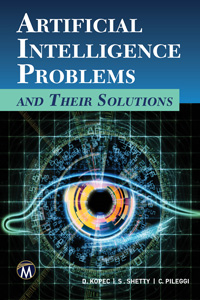 Artificial Intelligence Problems and Their Solutions
Artificial Intelligence Problems and Their Solutions
ISBN: 978-1-938549-83-0
Pub Date: March 2014
Specs: 6 x 9 Paperback with CD
Pages: 300
Price: $49.95
This book lends insight into solving some well-known AI problems using the most efficient methods by humans and computers. The book discusses the importance of developing critical-thinking methods and skills, and develops a consistent approach toward each problem: 1) a precise description of a well-known AI problem coupled with an effective graphical representation; 2) discussion of possible approaches to solving each problem; 3) identifying and presenting the best known human solution to each problem; 4) evaluation and discussion of the Human Window aspects for the best solution; 5) a playability site where students can exercise the process of developing their solutions, as well as “experiencing” the best solution; 6) code or pseudo-code implementing the solution algorithm, and 7) academic references for each problem. This book is intended as a companion to any course in computer science or mathematics where there are interesting problems to solve.
FEATURES
- Addresses AI problems well known to computer science and mathematics students from a number of perspectives
- Covers classic AI problems such as Twelve Coins, Red Donkey, Cryptarithms, Rubik’s Cube, Missionaries/Cannibals, Knight’s Tour, Monty Hall, and more
- Includes playability sites where students can exercise the process of developing their solutions
- Problem solving methods which may be applied to many problem situations
BRIEF TABLE OF CONTENTS
1. Problem Solving in AI 2. The Human Windows 3. Missionaries and Cannibals 4. Twelve Coins Problem 5. Cryptarithms 6. The Red Donkey Puzzle 7. The Fifteen Puzzle 8. Knight’s Tour 9. Mastermind 10. The Monty Hall Problem 11. Rubik’s Cube 12. The Prisoners’ Dilemma 13. Miscellaneous Problems 14. Summary/Conclusion 15. Appendix- Program Code.
ABOUT THE AUTHORS
Daniel Kopec has published more than 80 academic articles on computer chess, AI, intelligent tutoring systems, and computer science education. He is the author of Artificial Intelligence in the 21st Century and several chess books. Shweta Shetty is an SAP PI Consultant. Christopher Pileggi holds a degree in Computer Information Science.
SHORT DESCRIPTION OF BOOK:
This book is intended as a companion to any course in computer science or mathematics where there are interesting artificial intelligence problems to be solved and lends insight into how well-known AI problems can be solved most efficiently by both humans and computers.

